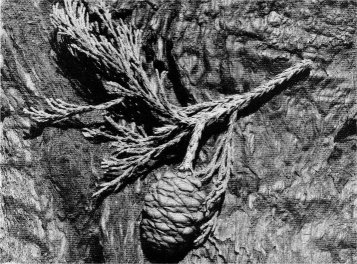There are over fifty differences
between the two kinds of trees, in
many other respects similar. The
characteristics which they have in
common are: Evergreen, cone-bearing,
reddish bark and reddish heartwood,
absence of resin cells and
abundance of tannin.
|
GIANT SEQUOIA |
COAST REDWOOD |
|
Reproduction and Growth:
|
| |
Cones, large 1 3/4 to 2 3/4 inches
long; mature second season; may
be retained up to 20 years.
Cone scales, from 35 to 40 in each
cone.
Seeds, from 150 to 300 in each
cone.
Reproduction by seeds only.
Young trees not tolerant of
shade.
Mixed stands generally found.
|
Cones, smaller, from 5/8 inch to 1 1/8
inches long; mature first season;
shed the first season.
Cone scales, from 14 to 24 in each
cone.
Seeds, from 50 to 60 in each cone.
Reproduction by seeds and root
sprouts.
Young trees moderately tolerant of
shade.
Pure stands often found.
|
|
|
Cultivation:
|
| |
Moderate use in reforestation.
Extensive planting as ornamental
in Europe, Asia, and many
parts of North America.
|
Extensive use in reforestation.
Extensive planting as ornamental
in Hawaii, New Zealand, southern
Europe, and warmer parts of North
America.
|
|
|
|
Bark, Leaf and Root Characters:
|
| |
Rich cinnamon-brown bark.
Bark deeply furrowed with large
ridges.
Bark from 1/2 to 2 feet thick at
base of trunks of large trees.
Leaves small, scale-like, resembling
those of juniper or cypress.
Leaves awl-shaped, sessile, 1/12
to 1/2 inch long, appressed all
around the stem.
Root spread from 100 to 150 feet
from base of tree at from 6-8 feet
below surface of ground.
|
Dull red, richly colored bark.
Bark shallowly fissured with small
ridges.
Bark from 1/4 to 1 foot thick at base
of trunks of large trees.
Leaves flat, needle-like, resembling
hemlock or fir leaves.
Leaves linear, petioled, from 1/4 to
1 1/4 inches long, spreading in two
flat ranks.
Root spread from 40 to 50 feet
from base of tree at from 4-6 feet
below surface of ground.
|
|
|
Commercial Uses:
|
| |
Wood brittle, light and weak.
Wood has a tendency to break
crosswise when tree is felled.
Waste in lumbering from 45 to
50 per cent (up to 80% in large
trees).
Almost no lumbering at the
present time.
|
Dry weight of wood 26.2 lbs. per
cu. ft.
Wood has a tendency to split
lengthwise when tree is felled.
Waste in lumbering from 25 to 50
per cent.
Over half a million board feet lumbered
each year; the redwood lumber
of commerce.
|
|
|
Burls:
|
| |
Burls cut from tree will not grow
new foliage.
Burls have little commercial
value.
|
Burls cut from tree and placed in
moist location will grow new
foliage.
Burls valuable for table tops,
curios, etc.
|
|
|
Size and Age:
|
| |
Average diameter of mature trees
from 28 to 32 feet.
Maximum known base diameter
40.3 feet.
Height of many trees from 250
to 300 feet.
Average age of mature trees from
2,000 to 3,000 years.
Greatest reported age 4,000 years.
|
Average diameter of mature trees
from 12 to 16 feet.
Maximum known base diameter. 22.8
feet.
Height of many trees from 300 to
350 feet.
Average age of mature trees from
800 to 1,500 years.
Greatest reported age 2,000 years.
|


